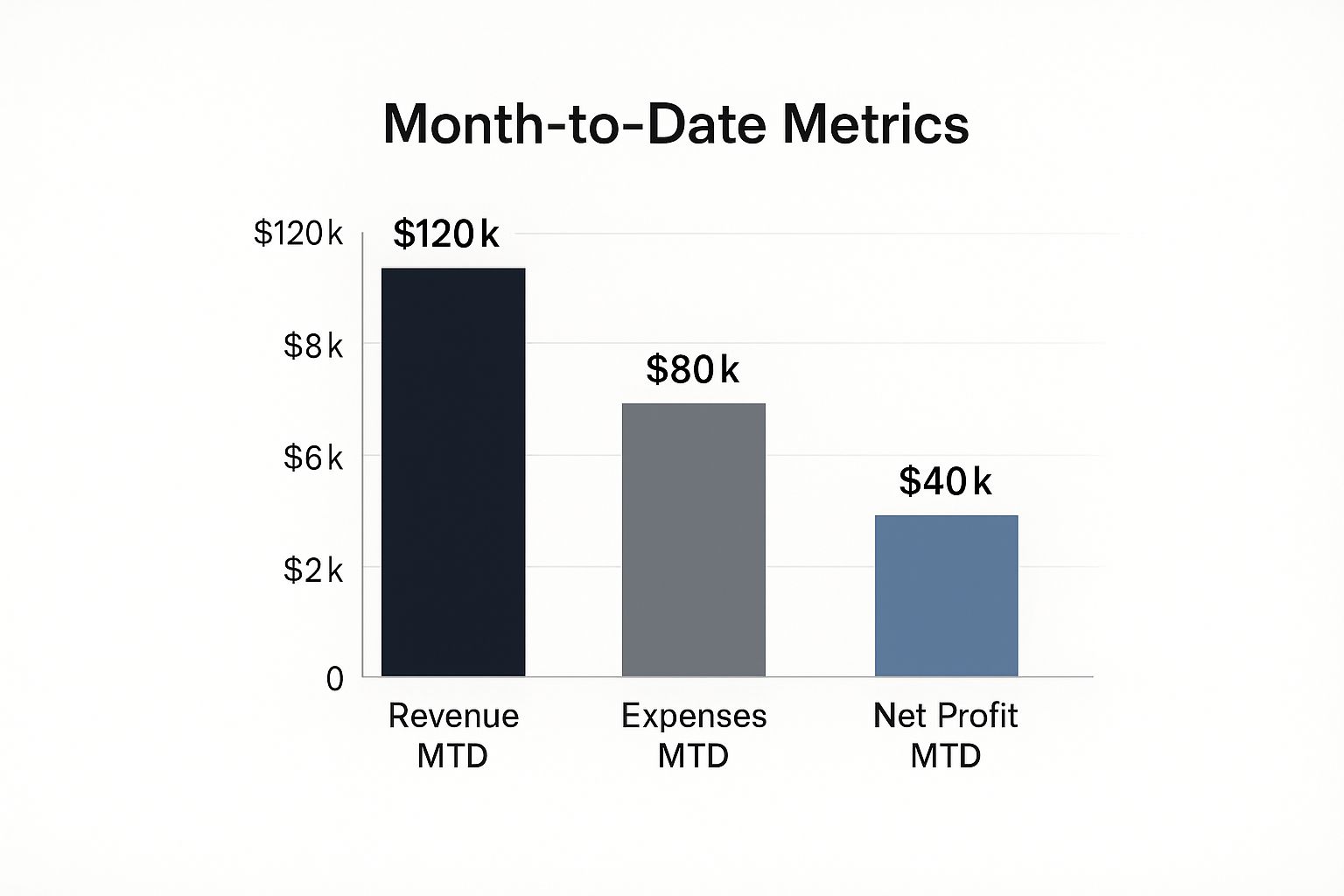Month to Date Meaning for Business Reporting
Unlock the month to date meaning for business. Learn to calculate MTD and use it for smarter financial, marketing, and PPC decisions with our clear guide.

When you hear the term month to date, don't overcomplicate it. It’s simply a measurement of performance starting from the first day of the current month right up to today. Think of it as your monthly progress report, but in real time.
What Does Month to Date Actually Mean?

Month to Date (MTD) gives you a live look at how you're doing this month, right now. It cuts through the noise of historical data to tell you what's happening today.
Here's a simple analogy: Imagine you’re on a road trip. A full monthly report is like looking back at how many miles you drove last month. An MTD report, on the other hand, tells you how many miles you've covered on this month's leg of the journey, up to the exact moment you check.
This makes MTD an incredibly powerful tool for making quick, informed decisions. It offers a clear picture before the month is over, so you can tweak your strategy on the fly. You don't have to wait until the 31st to fix a problem that started back on the 5th.
Key Takeaway: The real power of MTD is its immediacy. It turns data from a rearview mirror into a GPS, helping you navigate the month ahead proactively instead of just reacting to what’s already happened.
How MTD Is Used in the Real World
The concept of month to date is useful for much more than just sales figures. It's a go-to metric in finance and other departments for keeping a finger on the pulse of current trends.
For example, investment managers rely on MTD returns to assess portfolio performance without waiting for the end of the month. In one period, UK equities showed a 4.4% MTD return despite facing market headwinds, proving how MTD can highlight strength even in tough conditions. In that same timeframe, other assets like global inflation-linked bonds posted a 4.7% MTD return, showing its broad applicability. You can dig into similar market insights on the J.P. Morgan Asset Management site.
To make it even clearer, here’s a quick summary of what makes up the MTD timeframe.
Month to Date at a Glance
This table breaks down the simple but crucial components of any Month to Date calculation.
| Component | Explanation |
|---|---|
| Start Date | Always the 1st day of the current calendar month. |
| End Date | Today's date (the day you pull the report). |
| Purpose | To measure performance and spot trends within the current month. |
Understanding these three parts is all you need to start using MTD to get a clearer, more immediate view of your business performance.
Forget the Complicated Math—Here's How to Easily Calculate MTD Performance
Figuring out your month-to-date performance shouldn't feel like a chore. It’s actually pretty simple. The whole point is to get a quick, accurate look at how you're doing right now in the current month.
When you want to see how much things have changed—like your sales growth—a straightforward formula is all you need. This gives you a great feel for your current momentum.
MTD Growth Formula: (Current Value - Start of Month Value) / Start of Month Value
Let's walk through a real-world scenario. Say you run a small online store. On June 1st, your monthly sales are, of course, $0. Fast forward to the morning of June 20th, and you've already brought in $11,500. Your goal for the entire month was $10,000.
To figure out how far ahead of schedule you are, the math looks like this:
- ($11,500 - $10,000) / $10,000 = 0.15
That 0.15 means you’re already 15% over your monthly sales goal, and you still have time to spare!
Just Add It Up: Tracking Cumulative Totals
Not every MTD metric needs a fancy percentage. For many of your most important numbers, or KPIs, all you really need is a running total. This is perfect for tracking anything that accumulates day by day.
Calculating a cumulative MTD total is as easy as it sounds: you just add up the value for each day, starting from the 1st of the month up to today. This works great for metrics like:
- Total Ad Spend: Keeping a running tally of your daily spend on platforms like Amazon PPC helps you stay on budget.
- Total Leads Generated: Counting up the new leads you get each day.
- Total Units Sold: Summing up the number of products you've moved since the month began.
- Total Website Clicks: Adding up daily clicks from your ad campaigns to see how much traffic you’re driving.
For example, let's say your Amazon ad spend was $100 on day one, $120 on day two, and $95 on day three. Your MTD ad spend after those three days is simply $315 ($100 + $120 + $95). This kind of basic addition is at the heart of understanding the month to date meaning for your campaign budgets, giving you the immediate feedback you need to manage your advertising well.
Why MTD Is Your Business’s Early Warning System

Think about it this way: waiting until the end of the month to review your performance is like checking the smoke alarm after you see flames. By the time you get the report, the damage is done. Month-to-date (MTD) reporting flips that script entirely. It’s not a historical document; it's a live feed that lets you spot trouble—and opportunity—while there’s still time to act.
Let's say you're managing a retail store. Halfway through the month, you check your MTD foot traffic and notice a sharp dip compared to your goals. Instead of discovering a disastrous sales report three weeks from now, you can react today. Maybe you launch a flash sale, adjust staff schedules, or boost your local ads to get people back in the door.
This is what being proactive is all about. It’s not just about catching the bad stuff early. If a new ad campaign is crushing it by day 10, your MTD data gives you the green light to pour more budget into it and ride the wave.
Key Insight: MTD isn’t just about looking at numbers. It’s about making smart, timely decisions that stop small hiccups from turning into big problems.
Spotting Trends Before They Become Problems
This real-time perspective is valuable far beyond a single business. Financial analysts, for example, rely on MTD data to get a pulse on the entire economy. A preliminary MTD report showing U.S. housing starts are down 9.8% can signal a slowdown in construction, giving investors a heads-up before the official numbers are even released. You can see this in action on platforms that provide economic calendars and forecasts.
At its core, MTD offers a predictive snapshot. By keeping a close eye on your MTD metrics, you can get ahead of the game.
Here’s what that looks like in practice:
- Prevent Budget Overruns: See ad costs creeping up mid-month? You can pull back before you blow your entire budget.
- Optimize Your Inventory: Notice a product flying off the shelves faster than usual? Reorder it now, not when you’re already out of stock.
- React to Market Shifts: A competitor launches a surprise sale? Your MTD data shows the impact on your sales almost immediately, so you can respond.
Ultimately, MTD gives you the agility to steer your business with precision, ensuring you’re always heading in the right direction.
Using MTD to Get Ahead in PPC and Digital Marketing
For anyone running Pay-Per-Click (PPC) campaigns, understanding month-to-date performance is what separates guessing from knowing. This is where the MTD concept stops being just a definition and starts making you money, especially on fast-moving platforms like Amazon and Google.
The best advertisers are constantly looking at their MTD data. It’s what lets them make small, daily tweaks that add up to big wins by the end of the month. You end up miles ahead of competitors who only check their reports after the month closes—long after the budget has been wasted.
Think about it this way: It’s the 15th of the month. An Amazon seller glances at her MTD dashboard and sees her Advertising Cost of Sale (ACoS) has ballooned to 40%, way over her 25% goal. Without MTD data, she wouldn't have a clue until the month was over. But because she checked, she can jump right into her campaigns, find the keywords burning cash, and cut their bids. She just saved herself from wasting another two weeks of ad spend.
This is what being proactive really looks like. It's about spotting problems early enough to actually fix them.
The MTD Metrics That Really Matter
To make these quick, smart decisions, you have to know which numbers to watch. While every campaign has its own goals, there are a few core metrics that give you the control you need.
Focus your MTD check-ins on these key performance indicators:
- Ad Spend: How much have you spent so far this month? Keeping an eye on this ensures you're on track with your budget and not heading for a surprise overspend.
- Sales/Revenue: Are your ads actually making you money? Tracking MTD sales shows you if you’re moving in the right direction.
- Return on Ad Spend (ROAS): This is the ultimate efficiency metric. If your MTD ROAS is dropping, it’s a bright red flag that something in your campaigns needs immediate attention.
- Clicks and Impressions: These are your early warning signs. A sudden nosedive in MTD impressions could mean your ads have stopped showing, while fewer clicks might point to weak ad copy or new competition muscling in.
When you track these metrics from day one of the month, you’re not just looking at numbers. You’re building a clear story about your campaign’s health and where it’s headed.
MTD vs. QTD, YTD, and LTD: Choosing the Right Lens for Your Data
Knowing what "month to date" means is a great start, but its real value comes alive when you see how it stacks up against other common time-based metrics. Honestly, picking the wrong timeframe for your analysis is like using a magnifying glass to look at the stars—you’ll see something, but you'll completely miss the bigger picture.
I like to think of it like a road trip. MTD is like glancing at your trip meter to see how many miles you've covered today. It's a quick, tactical snapshot that helps with immediate decisions. If you're running low on gas, you’re checking this metric to decide if you need to pull over at the very next exit.
This dashboard is a perfect example of an MTD snapshot, giving you a visual rundown of key metrics for the current month.

A quick look at this chart tells you the business has already pulled in a $40k net profit this month. It's an instant health check.
Comparing Strategic Timeframes
While MTD is your go-to for tactical, in-the-moment adjustments, other metrics offer a much broader, more strategic view. Each one is designed to answer a different kind of question about your business's performance.
The Main Takeaway: Picking the right metric comes down to your goal. Are you making a quick tweak to an Amazon PPC campaign? MTD is your best bet. Are you planning your budget for the entire next year? Then you'll want to look at YTD.
Let's quickly break down the other acronyms you'll run into.
This table breaks down the differences between MTD, QTD, YTD, and LTD to help you choose the right metric for your analysis.
Comparison of Time-Period Metrics
| Metric | Timeframe | Primary Use Case |
|---|---|---|
| MTD | From the 1st of the current month to today | Daily/weekly tactical adjustments and campaign pacing. |
| QTD | From the start of the current quarter to today | Reviewing progress against 90-day goals and quarterly targets. |
| YTD | From January 1st of the current year to today | Tracking annual performance and long-term goal pacing. |
| LTD | From the very beginning of tracking to today | Assessing overall historical growth and lifetime value. |
As you can see, each metric serves a distinct purpose. MTD is for the here and now, while the others help you zoom out and see the larger trends shaping your business.
Best Practices for Effective MTD Tracking

So, how do you turn MTD from a simple definition into a powerful habit for your business? It's not about anxiously refreshing your stats every hour. Real, effective MTD tracking is about building a sustainable system that delivers actionable insights without getting you stuck in analysis paralysis.
The first step is setting up a regular check-in routine. Whether it's a quick 15-minute review each morning or a deeper dive every Monday, consistency is what matters most. This rhythm helps you get a feel for the natural ebbs and flows of your business, stopping you from making knee-jerk decisions based on one off day.
Context Is Everything Compare Smartly
A number on its own is pretty useless. It’s just noise. To get real value from your MTD data, you have to compare it against other relevant time periods. This is what tells you whether your performance is actually good, bad, or just average.
Here are the most helpful comparisons to make:
- Previous Month: How does day 15 of this month stack up against day 15 of last month? This is a great way to measure your current momentum.
- Same Month, Last Year: Pitting your current MTD performance against the same period last year helps you spot seasonal trends and track year-over-year growth.
- Against Your Goals: Are you on track to hit your monthly sales target or ACoS goal? This is the most direct way to know if your current strategy is working or if it's time to make a change.
Don't overreact to small dips, especially early in the month. A slow first few days doesn't mean the whole month is a write-off. Look at your benchmarks to see the bigger picture before you act.
Finally, make your life easier by automating your reporting. Set up dashboards in your go-to tools, like the ones inside the Amazon Ads console. This saves a ton of time and ensures you always have a clear, current view of your performance without having to pull numbers manually every single day.
Common Questions About Month to Date
Even after you get the hang of what "month to date" means, a few specific questions tend to bubble up. Let's tackle some of the most common ones head-on.
Is MTD the Same as a 30-Day Rolling Period?
Nope, they're two different ways of looking at time, and you'd use them for different reasons.
Think of it this way: MTD always hits the reset button on the 1st of the month. This gives you a clean slate to measure how you’re doing within a specific calendar month. A 30-day rolling period, on the other hand, is a continuous snapshot of the last 30 days from whatever day you're looking.
Key Difference: MTD is locked to the calendar, which is perfect for hitting monthly targets. A 30-day view gives you a more stable, recent look at performance that isn't thrown off by the start of a new month.
Can I Use MTD for My Personal Budget?
Absolutely! MTD is a fantastic tool for managing your personal finances. It stops you from getting to the end of the month and wondering where all your money went.
For instance, if your monthly food budget is $600, checking your MTD spending on the 15th gives you a crucial mid-month reality check. If you've already spent $450, you know it's time to dial back for the next two weeks.
Is MTD Useful for a Brand-New Business?
Yes, and it’s arguably one of the most important metrics for a new venture. When you're just starting out, you don't have a deep well of historical data to draw from, like year-over-year growth.
MTD becomes your go-to for seeing what’s happening right now. It gives you immediate feedback on whether your launch strategies are gaining traction, allowing you to make smart, quick adjustments on the fly.
Ready to stop guessing and start growing your Amazon sales with data-driven PPC strategies? The team at Headline Marketing Agency uses advanced analytics to turn MTD insights into profitable actions. Discover how we can help you dominate your category by visiting us at https://headlinema.com.
Ready to Transform Your Amazon PPC Performance?
Get a comprehensive audit of your Amazon PPC campaigns and discover untapped growth opportunities.
